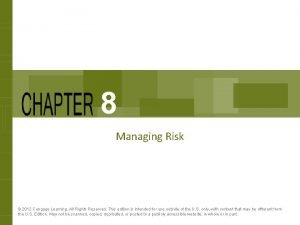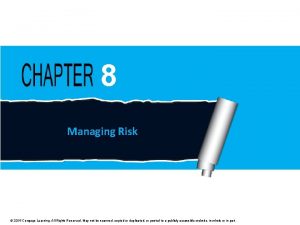8 Managing Risk 2012 Cengage Learning All Rights
















- Slides: 16

8 Managing Risk © 2012 Cengage Learning. All Rights Reserved. This edition is intended for use outside of the U. S. only, with content that may be different from the U. S. Edition. May not be scanned, copied, duplicated, or posted to a publicly accessible website, in whole or in part.

Chapter Concepts Identifying risks and their potential impact Assessing the likelihood of occurrence and degree of impact of risks Risk response planning Risk monitoring © 2012 Cengage Learning. All Rights Reserved. This edition is intended for use outside of the U. S. only, with content that may be different from the U. S. Edition. May not be scanned, copied, duplicated, or posted to a publicly accessible website, in whole or in part.

Learning Outcomes Discuss what is involved in managing risks Identify and categorize risks Assess and prioritize risks Prepare a risk response plan Develop a risk assessment matrix Monitor risks © 2012 Cengage Learning. All Rights Reserved. This edition is intended for use outside of the U. S. only, with content that may be different from the U. S. Edition. May not be scanned, copied, duplicated, or posted to a publicly accessible website, in whole or in part.

Project Management Knowledge Areas from PMBOK® Guide Project Risk Management © 2012 Cengage Learning. All Rights Reserved. This edition is intended for use outside of the U. S. only, with content that may be different from the U. S. Edition. May not be scanned, copied, duplicated, or posted to a publicly accessible website, in whole or in part.

Risk in Privatized Water Supply Projects in Indonesia Risks to Water Supply Success Political Macroeconomic Operational Business Land construction Force majeure Highest-Ranked Risks Non-availability of clean water Entry of new competitors Construction cost escalation Operation and maintenance cost escalation Defective equipment resulting in interruption © 2012 Cengage Learning. All Rights Reserved. This edition is intended for use outside of the U. S. only, with content that may be different from the U. S. Edition. May not be scanned, copied, duplicated, or posted to a publicly accessible website, in whole or in part.

RISK Risk is an uncertain event that, if it occurs, can jeopardize accomplishing the project objective. Risk management involves: § identifying, assessing, and responding to project risks in order to minimize the likelihood of occurrence and/or potential impact of adverse events on the accomplishment of the project objective. Risk identification includes determining: § which risks may adversely affect the project objective and estimating what the potential impacts of each risk might be. Learning. if it Alloccurs. © 2012 Cengage Rights Reserved. This edition is intended for use outside of the U. S. only, with content that may be different from the U. S. Edition. May not be scanned, copied, duplicated, or posted to a publicly accessible website, in whole or in part.

Risk Management Framework for Pharmaceutical Research and Development Projects Aspects of Project Risk Financial Technical Managerial Organizational Solutions Use structured approach to identify risks Work together to develop risk response plan Evaluate the life and death decisions and level of acceptance Use multivariate analysis of risks Apply a continuous risk assessment process © 2012 Cengage Learning. All Rights Reserved. This edition is intended for use outside of the U. S. only, with content that may be different from the U. S. Edition. May not be scanned, copied, duplicated, or posted to a publicly accessible website, in whole or in part.

Identify Risks Can jeopardize accomplishing the project objective Brainstorm sources of risks Establish categories for risks and evaluate Use historical information Progressively elaborate and identify new risks as more information becomes available © 2012 Cengage Learning. All Rights Reserved. This edition is intended for use outside of the U. S. only, with content that may be different from the U. S. Edition. May not be scanned, copied, duplicated, or posted to a publicly accessible website, in whole or in part.

Assess Risks Determine the likelihood the risk event will occur Evaluate degree of impact on the project objective Prioritize § Likelihood of occurrence and degree of impact § Position relative to the critical path © 2012 Cengage Learning. All Rights Reserved. This edition is intended for use outside of the U. S. only, with content that may be different from the U. S. Edition. May not be scanned, copied, duplicated, or posted to a publicly accessible website, in whole or in part.

Risk Assessment Matrix © 2012 Cengage Learning. All Rights Reserved. This edition is intended for use outside of the U. S. only, with content that may be different from the U. S. Edition. May not be scanned, copied, duplicated, or posted to a publicly accessible website, in whole or in part.

Plan Risk Responses Set of actions § Prevent or reduce the likelihood of occurrence or the impact of a risk § Implement if the risk event occurs Establishes a trigger point for implementing an action Assigns responsibility for implementation Avoid, mitigate, or accept the risk Include a contingency fund to cover implementation cost © 2012 Cengage Learning. All Rights Reserved. This edition is intended for use outside of the U. S. only, with content that may be different from the U. S. Edition. May not be scanned, copied, duplicated, or posted to a publicly accessible website, in whole or in part.

Student Discussion List ways to monitor risks for a project. © 2012 Cengage Learning. All Rights Reserved. This edition is intended for use outside of the U. S. only, with content that may be different from the U. S. Edition. May not be scanned, copied, duplicated, or posted to a publicly accessible website, in whole or in part.

Possible responses to Student Discussion List ways to monitor risks for a project. Regularly review the risk management matrix Evaluate all risks to determine if any changes Identify new risks Discuss during project meetings Track and document risks that occurred and their impact © 2012 Cengage Learning. All Rights Reserved. This edition is intended for use outside of the U. S. only, with content that may be different from the U. S. Edition. May not be scanned, copied, duplicated, or posted to a publicly accessible website, in whole or in part.

Managing Risks for Information Systems Development Risks can be categorized into seven types § § § § Technological risk Human risk Usability risk Project team risk Project risk Organizational risk Strategic and political risk © 2012 Cengage Learning. All Rights Reserved. This edition is intended for use outside of the U. S. only, with content that may be different from the U. S. Edition. May not be scanned, copied, duplicated, or posted to a publicly accessible website, in whole or in part.

IS Example: Risk Assessment Matrix © 2012 Cengage Learning. All Rights Reserved. This edition is intended for use outside of the U. S. only, with content that may be different from the U. S. Edition. May not be scanned, copied, duplicated, or posted to a publicly accessible website, in whole or in part.

Critical Success Factors Identify risks and their potential impacts before the project starts. Involve the project team or experts in assessing risks. Assign high priority to managing risks that have a high likelihood of occurrence and a high potential impact on the project outcome. Develop response plans for addressing high priority risks. © 2012 Cengage Learning. All Rights Reserved. This edition is intended for use outside of the U. S. only, with content that may be different from the U. S. Edition. May not be scanned, copied, duplicated, or posted to a publicly accessible website, in whole or in part.
 2012 cengage learning
2012 cengage learning Credit risk market risk operational risk
Credit risk market risk operational risk Delmar cengage learning medical terminology
Delmar cengage learning medical terminology Medical terminology chapter 5 learning exercises answers
Medical terminology chapter 5 learning exercises answers Cengage learning heart diagram
Cengage learning heart diagram South-western cengage learning
South-western cengage learning Chapter 13 medical math
Chapter 13 medical math 2009 delmar cengage learning
2009 delmar cengage learning Cengage learning heart diagram
Cengage learning heart diagram Chapter 1 learning exercises medical terminology
Chapter 1 learning exercises medical terminology Cengage learning australia
Cengage learning australia 2009 delmar cengage learning
2009 delmar cengage learning Whille
Whille Cengage learning
Cengage learning Wadsworth cengage learning
Wadsworth cengage learning Cengage learning
Cengage learning Cengage learning plant cell
Cengage learning plant cell































